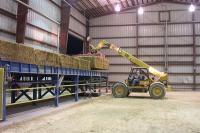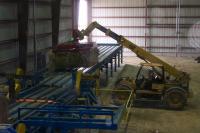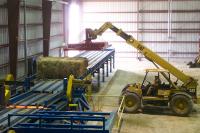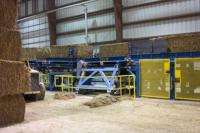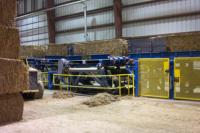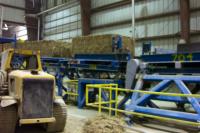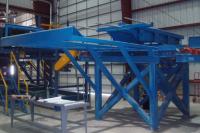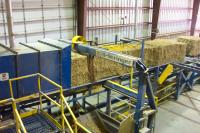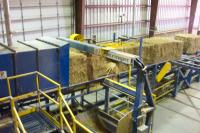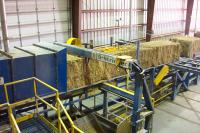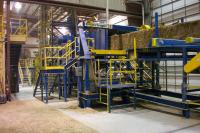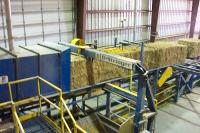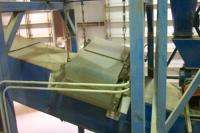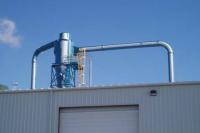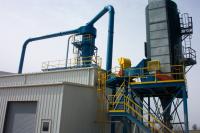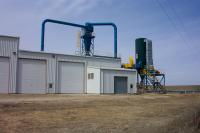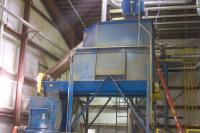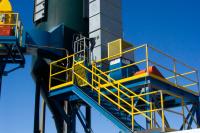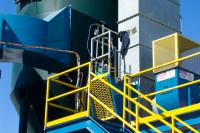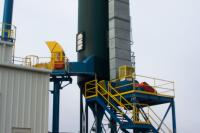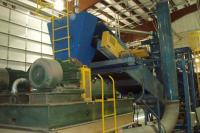Co-firing Process:


Click on a region in the diagram above to view get photos and information about each part of the processing system.
Twin Bale Conveyor
Bales are loaded onto the twin bale conveyor with a four bale grapple attached to a teleboom loader. This 'double wide' design provided a shorter conveyor that could hold up to 12 bales. A single line conveyor that could hold this many bales would extend farther than the building allowed. Allowing 12 bales of capacity only required loading once an hour.
Bale Merge Conveyor
The merge conveyor is a 'double wide' conveyor as well. This conveyor accepts bales from the twin bale conveyor and swings from side to side to load bales one at a time onto the single processing line.
Bale Sensing Conveyor
As bales are transported across the bale sensing conveyor, an infrared sensor measures the moisture content of the bale and a digital scale measures the bale weight. This information is transmitted instantaneously to the control system interface and is recorded by the data tracking system.
Bale Rejection Conveyor (Kicker)
The bale kicker is responsible for removing bales from the processing line. The control system is automated to remove bales that have moisture limits above a certain threshold. This threshold is set by the operator. The operator may also manually remove bales at the control interface. The bale kicker is located just past the bale sensing conveyor on the processing line and resembles a large pitch fork that pushes bales horizontally onto a platform for removal.
De-Stringer
The destringer removes the twine from the bales. A blade cuts the twine from underneath and a set of hooks remove it from above the bale. It is positioned just prior to the entrance to the debaler.
Debaler
The debaler is the first of two hammermills on the processing line. As the bale enters, it is chopped from the top and bottom by two horizontal counter rotating sets of hammers run by dual 200 hp electric motors. The switchgrass must pass through a two-inch screen before exiting the debaler.
As the debaled switchgrass exits below the debaler, a Debaler to Eliminator Conveyor transports the material to the eliminator entrance.
Magnetic Belt, Vacuum Cyclone
The magnetic belt rotates above the debaler to eliminator conveyor. This removes any metals before entering the eliminator.
Primary Cyclone
The pulverized switchgrass that drops from the eliminator is transported to the primary cylone. The primary cyclone separates the larger constituents of switchgrass from the more fine and dust-like particles through taking advantage of rotational effects of air and gravity. The heavier material is dropped out into the surge bin. The finer, lighter materials are evacuated to the baghouse.
Surge Bin/Airlocks
As switchgrass is dumped into the surge bin, the material is in final processed form and ready to be sent to the OGS boiler for firing. The surge bin is essentially a staging container that holds switchgrass before it enters the pneumatic transport system. Two screw feed conveyors at the bottom of the bin push the switchgrass into the rotary airlocks.
The rotary airlocks transport switchgrass from the surge bin into the pressurized pneumatic transport pipes. This equipment allows for the transfer of material into the pneumatic pipes without any loss of pressure.
Cyclone Baghouse
A 20,000 cubic feet per minute centrifugal blower attached to the baghouse draws air from the eliminator exit, through the primary cyclone, and finally into the baghouse. Switchgrass that passes through the primary cyclone enters the baghouse through a tangential air duct. Due to its height, the baghouse is located on the outside of the process building. The baghouse works similarly to the primary cyclone, separating the material by size. The larger particles drop to the bottom while the smaller particles are forced onto a series of polyester bag filters. The dust that is collected on the bag filters is removed using a pulsed air jet on the clean side of the bags. All collected and filtered material exits through a rotary airlock at the bottom of the baghouse.
Baghouse Fan and Ductwork
As the switchgrass exits through the rotary airlock at the bottom of the baghouse, the baghouse belt conveyor transports the material into the surge bin back inside the process building. This conveyor is totally enclosed and kept at slight negative pressure to minimize dust accumulation.
Pneumatic Transport Blowers & Transport Piping
Two positive displacement 100 hp rotary blowers force the switchgrass through the transport piping to opposing corners of the east fireball in the OGS boiler. The transport piping extends approximately 1,500 feet from the switchgrass process building to the OGS boiler.
Attrition (Eliminator) Mill
The attrition mill, or 'Eliminator', is the second and final milling stage of the processing system. Switchgrass enters the top of the eliminator and is pulverized using two horizontal side-by-side counter-rotating hammers. The mill's rotors are each powered by a 300 hp electric motor.


